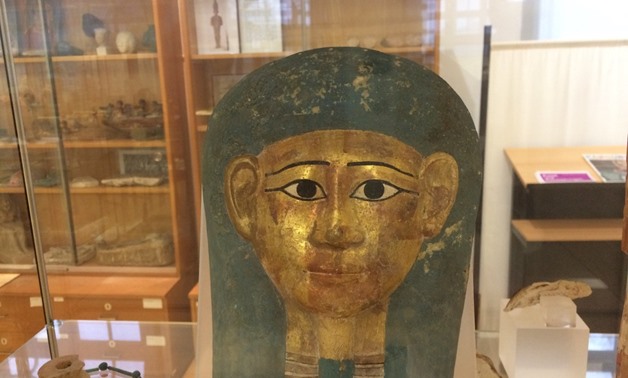
The gold-plated mask of Pen-ta-hut-hetep- Egypt Today-Samar Samir
BONN/ Germany- 17 December 2018: Millions of people come from all over the world to Berlin to see the 3,500-year-old bust of Pharaonic Queen Nefertiti in Neues Museum; meanwhile, 3,000 Egyptian artifacts are exhibited in Rhineland, West Germany.
At the Egyptian Museum of the University Bonn, the ancient pieces show how the ancient Egyptians lived.
In the early 19th Century, more than 1,800 artifacts were dedicated to professor and theologian I.M. Augustin Scholz, who was teaching at the university at the time. Other objects were given to the university in different occasions.
According to the museum's official website, the Academic Art Museum handed many artifacts to the Egyptian Museum of the University of Bonn in 1928; however, World War II destroyed many artifacts in a bombing that occurred in October 1944.
In 1955, archeologist and Professor Elmar Edel (1914-1997), who had an expedition mission in Upper Egypt’s Aswan, donated hundreds of artifacts to the museum, which re-opened in 2001.

Mumified skull an a clay-made mask- Egypt Today- Samar Samir
Qubbet el-Hawa artifacts
The museum’s masterpieces came from the archaeological site of Qubbet el-Hawa in Upper Egypt’s Aswan. The artifacts date back to different ages, including the Old Kingdom, Middle Kingdom, New kingdom and the Ptolemaic era.

Mumified animals at the Museum - Egypt Today Samar Samir
The museum’s main icon is a gold-plated mask of Pen-ta-hut-hetep, dating back to the Ptolemaic era. It is one of the Qubbet el-Hawa artifacts. A picture of the mask is used as the museum’s logo.
Also, a bowl with drawings of a warrior surrounded by a number of tigers is one of the Qubbet el-Hawa artifacts shown at the museum. The bowl dates back to the 11st Dynasty (2100 BC).

Funerary equipment- Egypt Today- Samar Samir
Moreover, a group of pots, made of ceramic, was unearthed from Qubbet el-Hawa cemetery and are shown at the museum’s glass booth. The whole set dates back to late Old Kingdom-era (2300-2100 BC).
Other masterpieces
An18th Dynasty scribe is one of the most important pieces shown at the museum. It was given to the museum by German Egyptologist Alfred Wiedemann. Unfortunately, the documents of the scribe were destroyed during WWII, according to the official website of the museum.

Canopic box from the Ptolemaic period - Egypt Today-Samar Samir
A large replica of Seti I-era relief that depicts a war scene from the Pharaonic history is also shown in the museum. The original relief inhabits Karnak Temple in Luxor. The museum also exhibits a model of Medinet Habu Temple, which is known as “Million Year House’ Temple of Ramses III"; the temple was built to be the king’s funerary cult.
Additionally, a group of small artifacts representing the myth of Osiris, Isis, and Horus the Child is shown. The myth tells the story of the death and resurrection of Osiris and how his sister-wife Isis helped with his resurrection and took care of Hours the Child.
Also, the museum exhibits dozens of Pharaonic amulets, funerary equipment and mummified skulls.

Amulets - Egypt Today- Samar Samir
Furthermore, a collection of other antiquities was shown to narrate how ancient Egyptians believed that animals have sacred powers. The collection includes mummified cats, which were believed to be a source of illness and war on one hand, and love and affection on the other.
The museum also hosts a wooden cover of a sarcophagus lent to the museum by the Museum of Grevenbroich in Germany. The cover dates back to the Ptolemaic Era (300-100 BCE), the same period to which an exhibited chest belongs. The chest was used to contain the internal organs of the mummies.
The museum exhibits a papyrus dedicated from the head of the Supreme Council of the Armed Forces (SCAF) and former Minister of Defense Mohamed Tantawi to German former Minister of Defense Gerhard Stoltenberg on February 5, 1992.

A group of artifacts depicting the Myth of Osiris, Isis, and Hours- Egypt Today- Samar Samir

a model of Temple of Medinet Habu- Egypt Today- Samar Samir







Comments
Leave a Comment